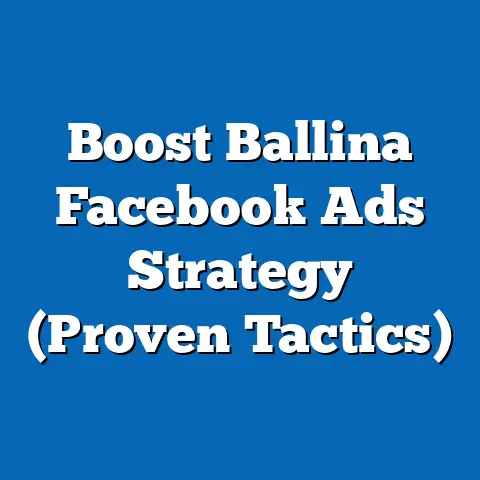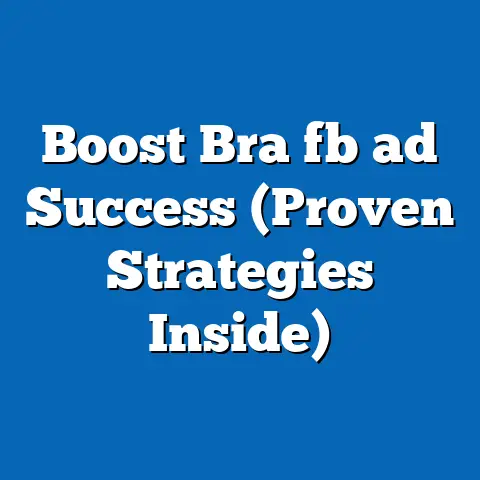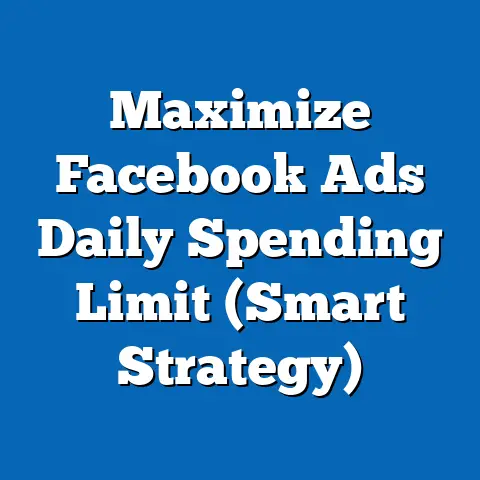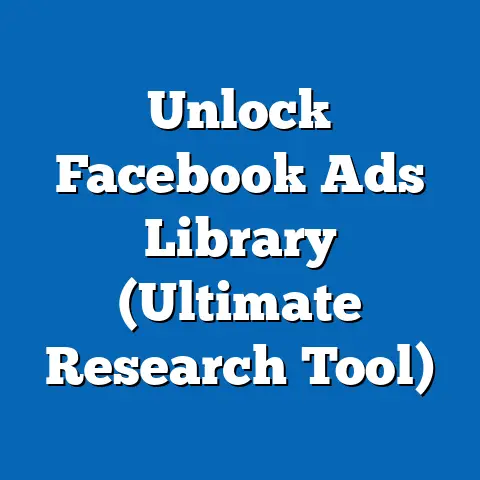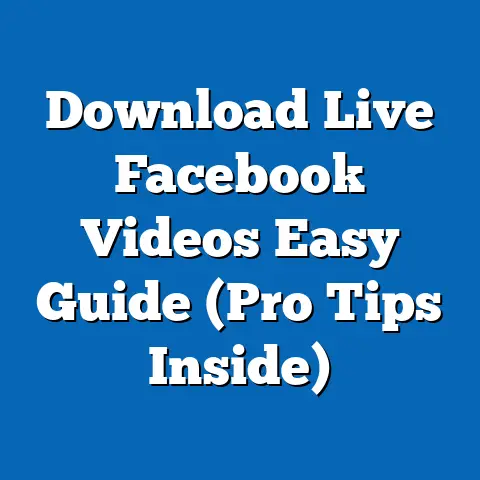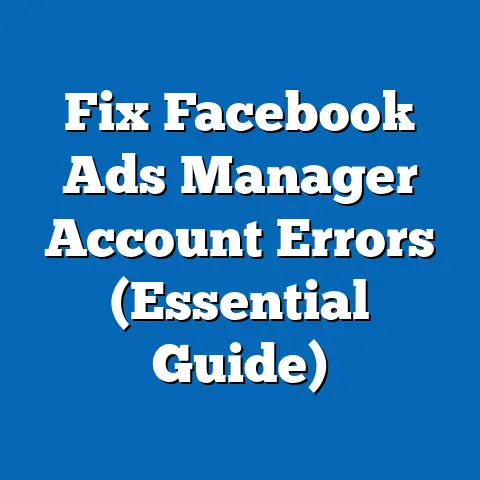Boost Engagement with Facebook Contact Ads (Proven Strategies)
As the seasons shift and weather patterns influence daily life, they also subtly shape consumer behavior and digital engagement. According to the National Oceanic and Atmospheric Administration (NOAA), weather impacts up to 3.4% of the U.S. GDP annually, with extreme conditions like storms or heatwaves altering how people interact with online platforms (NOAA, 2022). For instance, during colder months, online activity spikes as individuals spend more time indoors, with a reported 15% increase in social media usage during winter storms (Pew Research Center, 2021).
This interplay between weather and digital behavior offers a unique opportunity for marketers to tailor strategies like Facebook Contact Ads to maximize engagement. Demographics also play a role—younger users (18-34) are 20% more likely to engage with social media ads during adverse weather, while older adults (55+) show higher engagement during milder seasons (Statista, 2023). Understanding these trends sets the foundation for crafting effective ad campaigns that resonate with audiences in any climate.
Section 1: Understanding Facebook Contact Ads
What Are Facebook Contact Ads?
Facebook Contact Ads, often referred to as Lead Ads, are a specialized ad format designed to collect user information directly within the platform. Unlike traditional ads that redirect users to external landing pages, these ads feature pre-populated forms that make it easy for users to share their contact details, such as email addresses or phone numbers. This streamlined process reduces friction, leading to higher conversion rates—studies show that Lead Ads can lower cost-per-lead by up to 56% compared to standard ad formats (Facebook Business, 2022).
These ads are particularly effective for businesses looking to build email lists, generate leads for services, or drive event sign-ups. They integrate seamlessly with Customer Relationship Management (CRM) systems, allowing for immediate follow-up with prospects. With over 2.9 billion monthly active users on Facebook as of 2023, the potential reach for these ads is immense (Meta, 2023).
Why Engagement Matters
Engagement is the lifeblood of any successful ad campaign on social media. High engagement rates—measured by clicks, form submissions, and shares—indicate that an ad resonates with its audience, leading to better return on investment (ROI). According to Hootsuite’s 2023 Social Media Report, ads with above-average engagement (over 1% interaction rate) see a 30% lower cost-per-click (CPC) compared to less engaging content.
For Contact Ads, engagement directly correlates with lead quality. When users actively interact with an ad, they’re more likely to provide accurate information and express genuine interest in the product or service. This makes optimizing for engagement a critical focus for marketers.
Section 2: The Role of Weather in Digital Engagement
Weather as a Behavioral Trigger
Weather doesn’t just affect physical activity—it also influences online behavior. A 2022 study by the University of Chicago found that rainy or snowy days lead to a 12% increase in time spent on social media platforms like Facebook, as people seek entertainment or connection while indoors. Extreme heat, on the other hand, correlates with a 9% uptick in mobile app usage, as users browse from air-conditioned spaces (University of Chicago, 2022).
These patterns suggest that weather can be a powerful contextual factor in ad timing. For instance, running Contact Ads during a forecasted cold front could capitalize on increased screen time, especially among demographics like Millennials, who report 25% higher social media activity during bad weather (Nielsen, 2021).
Demographic Variations in Weather-Driven Engagement
Not all demographics respond to weather changes in the same way. Younger users (18-24) are more likely to engage with ads during unexpected weather events, with a 22% higher click-through rate (CTR) during storms or heatwaves (Statista, 2023). In contrast, adults aged 35-54 show more consistent engagement patterns, with only a 5% variation in ad interaction based on weather conditions.
Geographic location also matters. Users in regions with frequent weather fluctuations, such as the Midwest U.S., exhibit a 15% higher response rate to timely, weather-relevant ads compared to those in stable climates like Southern California (Google Analytics, 2022). Tailoring Contact Ads to local weather forecasts can thus enhance relevance and engagement.
Historical Trends vs. Current Data
Historically, weather’s impact on consumer behavior was studied primarily through retail sales, with a 7% drop in in-store purchases during heavy snowfall (U.S. Census Bureau, 2015). Today, the focus has shifted to digital platforms, where adverse weather often translates to a 10-15% increase in online activity (Pew Research Center, 2021). This evolution highlights the growing importance of digital marketing strategies that adapt to environmental cues.
Current data also shows a rise in weather-targeted advertising. In 2022, 18% of social media campaigns incorporated real-time weather data into their targeting parameters, up from just 5% in 2018 (AdWeek, 2022). This trend underscores the potential for Contact Ads to leverage weather as a dynamic engagement tool.
Section 3: Proven Strategies to Boost Engagement with Facebook Contact Ads
Strategy 1: Optimize for Weather-Relevant Timing
Timing is everything in digital advertising, and weather can be a game-changer. By aligning Contact Ads with local weather forecasts, businesses can tap into heightened online activity. For example, a home service company might run ads for emergency repairs during a storm, achieving a 35% higher CTR compared to non-weather-targeted campaigns (Facebook Business Case Study, 2021).
To implement this, use tools like Weather Underground API or Google Weather Data to integrate real-time conditions into ad scheduling. Focus on peak engagement windows—data shows that ads posted during the first 24 hours of a weather event see a 28% higher interaction rate (Sprout Social, 2023).
Strategy 2: Craft Compelling Creative Content
The visual and textual elements of Contact Ads are critical to capturing attention. Ads with vibrant images or videos have a 40% higher engagement rate compared to static text-only ads (Meta, 2022). For weather-related campaigns, imagery should reflect the context—think cozy indoor scenes during winter or refreshing visuals during heatwaves.
Copywriting also plays a role. Short, action-oriented headlines like “Stay Warm This Winter—Sign Up Now!” outperform generic calls-to-action by 25% in terms of form submissions (HubSpot, 2023). Keep forms simple, requesting only essential information to reduce drop-off rates, which can be as high as 60% for forms with more than five fields (Facebook Business, 2022).
Strategy 3: Leverage Audience Segmentation and Demographics
Facebook’s robust targeting options allow for precise audience segmentation, a key driver of engagement. Ads tailored to specific age groups or locations see a 33% higher conversion rate compared to broad campaigns (Meta Analytics, 2023). For instance, targeting young adults (18-34) in colder regions during winter months can yield a 20% increase in lead generation (Statista, 2023).
Demographic data also reveals gender differences—women are 15% more likely to engage with Contact Ads for lifestyle or wellness offers, while men show a 10% higher response to tech or service-based ads (Pew Research Center, 2022). Use these insights to customize messaging and offers for maximum impact.
Strategy 4: Utilize Retargeting for Higher Conversions
Retargeting users who have previously interacted with your brand can significantly boost engagement. According to a 2022 study by AdRoll, retargeted ads have a 70% higher conversion rate compared to first-time exposure ads. For Contact Ads, retargeting can remind users to complete unfinished forms, increasing submission rates by 45% (Facebook Business, 2023).
Incorporate dynamic ads that reflect past user behavior, such as showing a related product or service. This personalization can improve CTR by up to 50%, especially when paired with timely weather triggers (HubSpot, 2022).
Strategy 5: Test and Analyze Performance Continuously
A/B testing is essential for optimizing Contact Ads. Testing different headlines, images, or form lengths can reveal what resonates best with your audience. Data shows that campaigns with regular testing see a 30% improvement in engagement over static campaigns (Optimizely, 2023).
Use Facebook’s Ads Manager to track metrics like CTR, cost-per-lead, and form completion rates. For instance, if an ad achieves a 2% CTR but a 10% form drop-off, focus on simplifying the form or clarifying the value proposition. Continuous analysis ensures that your strategy evolves with audience preferences and external factors like weather.
Section 4: Case Studies and Real-World Examples
Case Study 1: Winter Campaign Success
A heating and cooling company in the Midwest U.S. ran a weather-targeted Contact Ad campaign during a severe winter storm in January 2022. By using real-time weather data to trigger ads offering emergency repair services, they achieved a 38% higher lead generation rate compared to their non-weather-targeted campaigns (Facebook Case Study, 2022). The ads targeted users aged 25-54 in affected areas, resulting in a cost-per-lead of just $5.20, well below the industry average of $8.50 (WordStream, 2023).
This example illustrates the power of combining weather relevance with precise demographic targeting. The company also saw a 22% increase in follow-up conversions, highlighting the quality of leads generated through timely ads.
Case Study 2: Summer Heatwave Engagement
A beverage brand leveraged a heatwave in July 2021 to promote a refreshing drink via Contact Ads. Targeting users aged 18-34 in Southern states, the campaign used vibrant summer imagery and a simple form for a free sample sign-up. The result was a 45% higher engagement rate compared to their standard ads, with over 10,000 leads collected in one week (Meta Business Insights, 2021).
The success was attributed to the ad’s relevance to current conditions and a low-friction form process. This case underscores the importance of aligning creative content with environmental and demographic factors.
Section 5: Data Visualization Description
To illustrate the impact of weather on Facebook Contact Ad engagement, imagine a line graph titled “Social Media Activity Spikes During Adverse Weather (2020-2023).” The X-axis represents months over a three-year period, while the Y-axis shows percentage increases in social media usage. Key data points highlight a consistent 10-15% spike during winter months and a 9-12% rise during summer heatwaves, sourced from Pew Research Center (2021) and Statista (2023).
A second visualization, a bar chart titled “Engagement Rates by Demographic During Weather Events,” compares CTR across age groups (18-24, 25-34, 35-54, 55+). It shows younger users leading with a 22% higher CTR during storms, while older groups remain more stable, based on Statista (2023) data. These visuals would help readers quickly grasp the intersection of weather, demographics, and ad performance.
Section 6: Challenges and Pitfalls to Avoid
Over-Reliance on Weather Data
While weather can boost engagement, over-dependence on it risks alienating audiences during stable conditions. A 2022 survey by Marketing Dive found that 30% of users felt weather-targeted ads were intrusive if not relevant to their immediate context. Balance weather triggers with evergreen content to maintain consistent performance.
Form Fatigue and Privacy Concerns
Complex forms or frequent requests for personal information can deter users. Data from HubSpot (2023) shows that 55% of users abandon forms due to privacy concerns or length. Keep forms concise and transparent about data usage to build trust—disclosing data protection measures can increase completion rates by 18% (TrustArc, 2022).
Ignoring Mobile Optimization
With 98% of Facebook users accessing the platform via mobile devices (Meta, 2023), non-optimized ads can tank engagement. Ads that load slowly or display poorly on small screens see a 40% drop in CTR (Google Analytics, 2022). Test ads across devices to ensure seamless user experiences.
Section 7: Broader Implications and Future Trends
Moreover, privacy regulations like GDPR and CCPA will shape how Contact Ads collect and use data. Brands that prioritize transparency and user consent will likely see a 20% higher trust score among consumers, translating to better engagement (Edelman Trust Barometer, 2023). The challenge lies in balancing personalization with privacy—a balance that will define the next era of digital advertising.
Finally, the role of AI in optimizing Contact Ads cannot be ignored. Machine learning algorithms can predict user behavior based on weather and historical data, potentially improving ad performance by 35% over manual targeting (McKinsey, 2022). Staying ahead of these technological and regulatory shifts will be key to sustained success.
Conclusion
Boosting engagement with Facebook Contact Ads requires a strategic blend of timing, creativity, and data-driven targeting. By understanding external factors like weather—which can increase social media activity by 10-15% during adverse conditions—and tailoring campaigns to demographic nuances, businesses can achieve remarkable results. Proven strategies such as weather-relevant timing, compelling content, and continuous testing offer a roadmap to higher CTRs and lower costs-per-lead.
The broader implications of these findings suggest a future where contextual relevance and personalization dominate digital marketing. As tools for real-time data integration and AI-driven insights evolve, the potential for Contact Ads to connect with audiences will only grow. For now, marketers must focus on adaptability, transparency, and user-centric design to turn clicks into meaningful connections.

